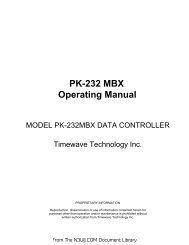Create successful ePaper yourself
Turn your PDF publications into a flip-book with our unique Google optimized e-Paper software.
While in SSB mode, the amplified signals from the bufferamplifier (Q1651) are then applied to the balanced modulator(<strong>IC</strong>201).While in AM/FM mode, the amplified signals from the bufferamplifier (Q1651) are applied to the limiter amplifier(<strong>IC</strong>1651b) and splatter filter (<strong>IC</strong>1651a). The signals arepassed through the buffer amplifier ((<strong>IC</strong>1652a) and are thenapplied to the AM detector (<strong>IC</strong>1807d, D1652) in AM mode orto the varactor diode (D253) in FM mode.4-2-4 TRANSMIT IF AMPLIFIER CIRCUIT(MAIN UNIT)The modulated IF signal from a modulation circuit is appliedto the IF amplifier circuit (Q1). The amplified IF signal is thenapplied to the VHF/UHF transmit circuit (PA unit) via the VHF/UHF switching circuit (D52, D53).The gain of the IF amplifier circuit (Q1) is controlled by theALC amplifier circuit (<strong>IC</strong>1601b). Therefore, the IF amplifieris reduced when the output power increases.4-2-2 MODULATION CIRCUIT (MAIN UNIT)(1) FM modeThe amplified audio signals from <strong>IC</strong>1701 are pre-emphasizedand limited at <strong>IC</strong>1651b and then passed through thesplatter filter (<strong>IC</strong>1651a). The filtered signals are then appliedto the FM modulation circuit (D253) via the FM deviationlevel controller (<strong>IC</strong>1803 pins 21, 22) and buffer amplifier(<strong>IC</strong>1652a). Also, subaudible tone signals from the CPU(DISPLAY board; <strong>IC</strong>1 pin 4) are applied to the FM modulationcircuit (D253) via the splatter filter (<strong>IC</strong>1651a).The FM modulation circuit changes the generating frequencyof the FM local oscillator (Q254, X251) to generate an FMsignal. The modulated IF signal is passed through the RFlimiter (Q253) and then applied to the transmit IF amplifiercircuit.When 9600 bps mode is selected, audio signals from theACC connector bypass the amplifiers and are applied to<strong>IC</strong>1654a directly via the external modulation switch (<strong>IC</strong>1531,pins 12, 1). In such cases, the deviation detector (<strong>IC</strong>1807d)cuts off the audio line when over modulation is detected.(2) SSB and CW modesThe amplified audio signals from Q1651 are mixed with BFOsignals at the balanced mixer circuit (<strong>IC</strong>201) to produce a 10MHz IF signal. The mixed signal is still a DSB signal, therefore,the mixed signal passes through bandpass filter circuit(FI151) to suppress unwanted side band signals. The filteredsignal is applied to the transmit IF amplifier circuit• Transmit IF frequenciesMode Transmit IF signalUSB10.8485 MHzLSB10.8515 MHzCW10.8491 MHz4-2-3 CW KEYING CIRCUIT (MAIN UNIT)When the CW key is closed, control signal is output fromCPU (LOG<strong>IC</strong> unit) and controls break-in operation, the sidetone signal.Keying signals (DOT and DASH) from the [KEY] jack(J1401) are applied to the CPU (DISPLAY board; <strong>IC</strong>1, pins49, 48 respectively), and the CPU outputs a CW control signal(KDS1) from pin 21. The CW control signal is applied tothe balanced mixer (<strong>IC</strong>201) via Q201, D201, D207 to unbalancethe <strong>IC</strong>201 input bias voltage and creates a carrier signal.R202 determines the transmit delay timing.4-2-5 RF CIRCUIT (PA UNIT)The RF circuit consists of mixer and drive amplifiers toobtain the desired frequency and level needed at a PA circuit,respectively.(1) VHF bandThe IF signal from the MAIN unit (P501) is mixed with an LOsignal from the VHF VCO circuit (PLL unit; Q191,D191–D194) at the double-balanced mixer circuit (Q501,Q502, D502) to be converted into VHF transmit frequency.The mixed signal is passed through the attenuator(R512–R514) and two-stage tunable bandpass filter (D503,L533 and D504, L504) to suppress spurious components.The filtered signals are then amplified at the YGR amplifier(<strong>IC</strong>501) and passed through the attenuator (R562–R531)and another two-stage tunable bandpass filter (D641, L641and D642, L642)The amplified and filtered RF signal is applied to the driveamplifier circuit that is used VHF and UHF signals commonly.(2) UHF bandThe IF signal from the MAIN unit (P1) is mixed with a 2nd LOsignal at the double-balanced mixer circuit (Q1, Q2) to producea 2nd IF signal (71.25 MHz). The 2nd LO signal (60.4MHz) is generated at the reference oscillator and doublercircuit (PLL unit; X512, Q551) via LO amplifier (<strong>IC</strong>40). The2nd IF signal is amplified at the buffer amplifier (Q3) via thebandpass filter circuit (L3, L4, C12, C13, C15–C17, C24,C26). The amplified 2nd IF signal is applied to the 1st mixercircuit (D190, L190, L191) passing through the attenuator(R12–R14) and low-pass filter (L381, L382, C381–C383).The 1st mixer circuit (D190, L190, L191) converts the 2nd IFsignal into a UHF transmit frequency with a 1st LO signalfrom the UHF VCO circuit (PLL unit; Q391, D391–D394).The converted RF signal is passed through the bandpass filter(FI200 and FI201) where unwanted LO signal emissionis reduced. The filtered signal is attenuated at R204–R206and amplified at the YGR amplifier (<strong>IC</strong>200), and is thenapplied to the drive amplifier circuit via the band pass filter(FI202) and another YGR amplifier (Q200).4-2-6 DRIVE AMPLIFIER CIRCUIT (PA UNIT)The drive amplifier circuit amplifies RF signals from the VHFor UHF RF circuit to obtain a level needed at the poweramplifier circuit. One drive amplifier circuit is commonly usedfor both VHF and UHF band signals.The signals from the VHF or UHF RF circuit are amplified atthe drive amplifier circuit (Q101, Q121, Q131, DRV board;Q930). The amplified VHF signals are passed through the4 - 4From The <strong>N3UJJ</strong>.COM Document Library
















